Simon Bainbridge, On
Composing Ad Ora Incerta
Rebecca
Jemian and Anne Marie de Zeeuw
British
composer Simon Bainbridge won the 1997 Grawemeyer Award in Music Composition
for his Ad Ora Incerta [At an Uncertain Hour]: Four Orchestral Songs
from Primo Levi for mezzo‑soprano, bassoon and orchestra.
Bainbridge wrote the work on a commission from the BBC at the instigation of
bassoonist Kim Walker. Brigitte Fassbaender was to have been the mezzo‑soprano
but, when she ended her career a few weeks before the premiere date, Christine
Cairns replaced her. The premiere took
place on March 29, 1995, with the BBC Symphony Orchestra conducted by Simon
Bainbridge. Ad Ora Incerta was
recorded in London on December 18, 1997, by the BBC Symphony Orchestra under
the direction of Martyn Brabbins, with soloists Sue Bickley, mezzo‑soprano,
and Kim Walker, bassoon. The recording also includes Four Primo
Levi Settings for mezzo‑soprano, clarinet, viola, and piano.
Who
is John Lambert to whom your piece is dedicated?
John
Lambert was my composition teacher in London.
I studied with him from 1969 to 1972.
He was far more than just a composition teacher during that period. Besides being a wonderful teacher, he was
somebody I would call if I had a musical problem. He never interfered with one's musical style,
but would just coax things out of the student.
His most amazing attribute was the way he trained you to hear not only
the moment but the overall structure and world of the composition. He had a very strong reason for having his
students write lots and lots of sixteenth‑century counterpoint: it makes
one think about the musical line and project a linear idea through the
composition. Doing those exercises
within a known style, stylistically observing certain rules, where it was
either right or wrong, gives students a very strong contrapuntal discipline,
and he would apply the same kind of thought processes to one's own
compositions. From the earliest days he
got me to plan my ideas by always working inwards from a large shape. Sadly, he died a few years ago now, which was
a great loss.
In
what order did you compose these songs?
"Buna"
was first, "Il canto del corvo" was second, and then we're in order:
"Il tramonto di Fossoli" was number three, and "Lunedi" was
number four.
Does
the annotation at the end of "Lunedi" give details about when you
finished the composition?
Yes. Although most of the composition was done in
London, this particular movement was sketched in a beautiful garden in
Montrosier in southwestern France where we stayed for about three or four
weeks. I finished the sketches at 4:40
p.m. on December 11, 1994, in London.
Why
did you choose these poems?
In
drawing up a short list of poems, I picked poems that appealed to me. It was gut reaction at first. In fact there were more than eight. That's why I decided to set the other poems
as a chamber music composition for piano, viola, clarinet and mezzo‑soprano. I regard that piece very much as a postscript
to Ad Ora Incerta. Although still
thinking about the poems, I gave myself a challenge and worked in a very
different way, because one doesn't have the vastness of the orchestra there.
The
poems I chose for Ad Ora Incerta were written in 1945 and 1946, shortly
after Levi was repatriated to Italy. So
there was a nearness to his experience of Auschwitz. There are some poems which were written in
the 1980s in that collection. Indeed
there were one or two which I was interested in, but I decided to concentrate
on his early poems.
One
other poem which I wanted to set was with me all the way through this period of
composition; it was Levi's re‑working of "Herbsttag" by Rainer
Marie Rilke. I set Rilke's text for
choir about a month before I started work on the Primo Levi poems. There was a connection; I had seen Primo
Levi's re‑working of the original, and I really admired it as a
fascinating example of re-composition.
Subsequently, I placed Levi's poem, "Da RM Rilke," in the chamber
music setting. That poem was very much
in my head when I started composition of the orchestral pieces.
How
did you choose their order?
The
order of composition was very different from the way the poems were eventually
assembled. "Buna," the first
piece I wrote, was the real discovery of the composition. I had nothing before that. I was literally going in cold and quite
terrified. Having a text is different
from writing abstract or instrumental music.
Obviously, the way that one plans out the composition is very important
with abstract music too. But here, I
realized that once I had selected the text, it didn't really matter where I
started, I just needed to go in somewhere.
In the beginning I thought "Buna" was going to be the first
piece. Once I could begin to feel the
large‑scale shape, the proportions and indeed the duration of
"Buna," an idea spun out about how the composition could develop.
Both
of your initiating points, "Buna"
and "Da RM Rilke," became the last pieces of your sets?
That's
right. The question of organization in
terms of ordering these poems was very complex actually. When I started writing the music, I didn't
put any page numbers on the score because I still couldn't work it out. The fifth song ["Da RM Rilke"] was
getting in the way. When I realized that
there wasn't a place for it in the cycle, I decided to get rid of it, and
immediately I felt the dramatic weight of the piece was on the final movement. Also, "Buna" is the most extended S
it doesn't use the voice at all times, it uses the orchestra very much to
develop the world of the poem S
whereas at least the two inner movements, "Il tramonto di Fossoli"
and "Lunedi," are very much songs in the sense that they evolve out
of the voice. I used the incredibly
strong imagery of "Il canto del corvo," which is more extensive, to
create a textural symphonic poem that gives some kind of placement for the
text.
The
final order of the poems seems to have an internal chronology and tells a story
effectively. For instance, the first
poem seems to have an appropriate location because it speaks of the crow's
flight across many miles to deliver bad news, although it doesn't say what the
bad news is.
That's
right.
What
did you conceive the relationship between Levi's poetry and your music to
be? The poetry is so powerful, personal,
and autobiographical. The music also has
to be powerful in order to balance the poetry.
How did you work on that?
One
of the qualities of Primo Levi's poetry which I think I admire more than
anything else S
indeed not just in his poetry but in all his writing S
is the fact that he never wore sentimentality on his sleeve. He was very objective in his writing,
observing almost from a distance. It is
such emotive poetry, it would be very easy to sentimentalize the
situation. I was careful to keep that
distance myself.
"Buna"
is undoubtedly the most powerful and tragic of the poems. It is the one that reveals descriptively the
camp and what went on there. I find it a
devastating poem. I think that's why I
had to start with that one. It drew me
into his language. I was aware of having
to hold back to create a language which did his poetry justice, without getting
in the way of it too much.
By
matching the restraint in the poetry you achieved the power in the piece?
Yes. I felt that restraint was definitely
required. There are, particularly in
"Buna," a lot of pointed dramatic moments. I had to organize those and to design moments
to articulate the text. A good example
of this occurs in "Lunedi," which is about the train journey to
Auschwitz. It was my intention in this
poem to hold back the voice completely.
That's why the voice has a sort of incantation. It hardly moves; it's almost all on one note
with the line and soul of the poem being given over to the bassoon. That was a very strong intention of mine
throughout, but this particular point was to change the balance of the
relationship between the bassoon and the voice.
Would
you talk a little bit more about the relationship that you created between the
voice and the bassoon? It seems to vary
with each song. The textural contrast
between the movements is so striking.
The second movement has a homorhythmic mirror between the two
parts. The third movement conveys a
sense of dialogue, perhaps, between the bassoon and the voice. In the last movement, the bassoon seems like
an obbligato instrument, almost in the manner of a Bach cantata.
Obviously
one of the challenges of this composition was coming to terms with that
relationship initially. When I started,
I was thinking of those wonderful arias by Mozart. I was not thinking of Bach. There's the concert aria "Per questa
bella mano," K. 612, for double bass and baritone. He also uses the clarinet a lot in La
clemenza di Tito; "Parto, parto, ma tu ben mio," the aria for
basset horn and soprano, is rather like a clarinet concerto.
The
idea of the obbligato instrument in relationship to the voice works very
well. I began to think about the
sonority and the tessitura of mezzo‑soprano voice and bassoon, thinking
particularly about where they would blend most successfully in the second song,
where I have them connected note for note all the way through, although mostly
in contrary motion. My aim here was to create one instrument in performance. It's incredibly hard having to blend the
colors of the two instruments. The sort
of vibrato used in articulating each note takes an awful lot of time to work
out.
I
was most conscious of using the bassoon in a different way in each movement, so
that each movement has a different relationship between the bassoon and the
voice. In the first movement, I used the
visual image of the crow flying across the landscape to create a character for
the bassoon, to give the effect almost of a bird in flight. [Refer to Example 1.]
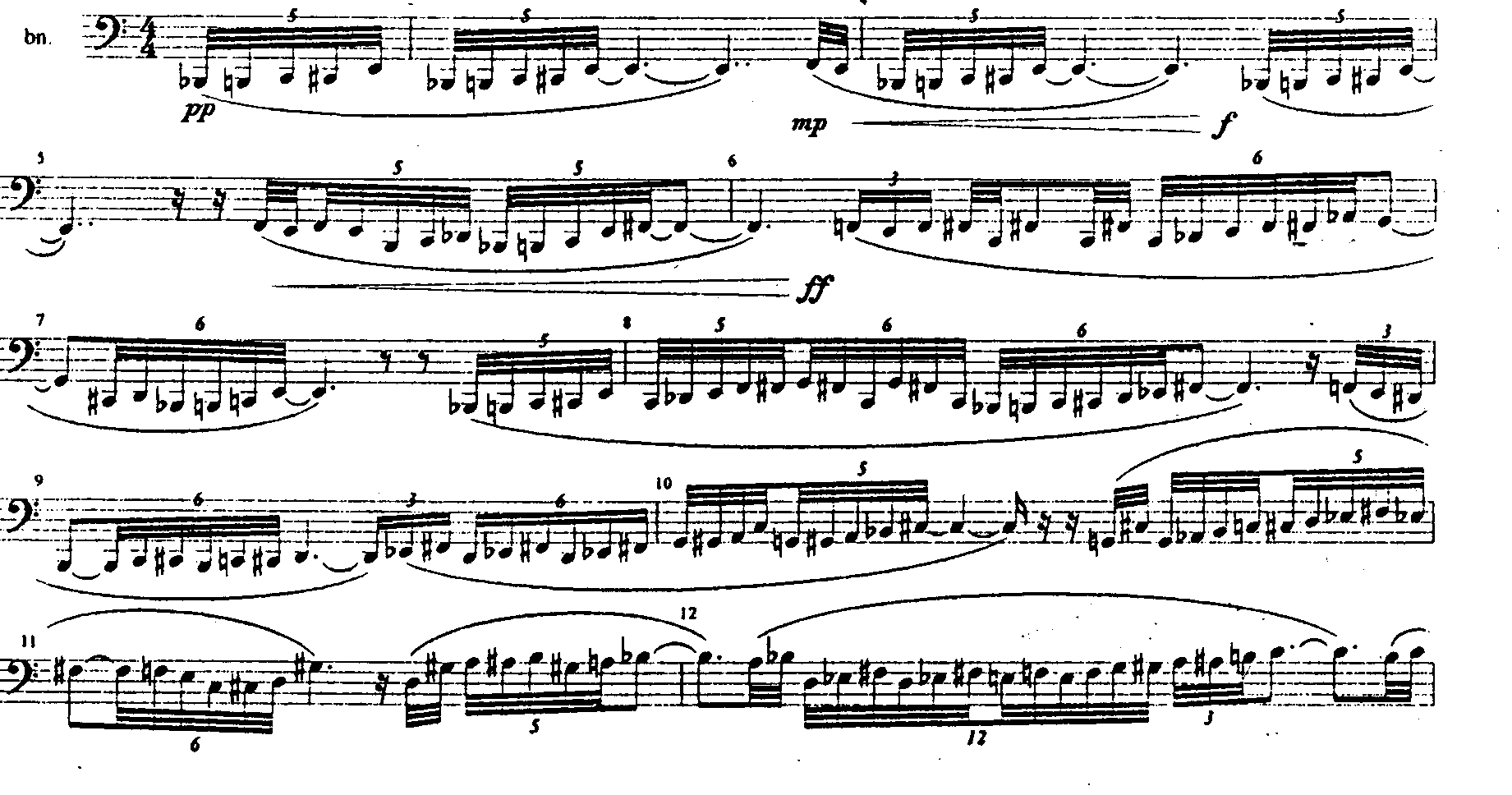
Example
1: Basson part, Ad Ora Incerta , First Movement
Does
that image consist of more than the fast notes symbolizing the fluttering of
the wings? Do you mean you're also
creating a line with the long notes to which the fast notes lead?
That's
right. I was trying to create a textural
orchestral image on which to convey the wonderful landscape of the poem. In the composition process of the first
movement it was the characterization of the bassoon that actually set the whole
thing off. Then I began to think about
the voice, which doesn't come in immediately anyway. The bassoon enters first, and it is almost a
mini‑concerto.
I
remember the way I discovered a musical object in the first movement. When I started work on "Il canto del
corvo," I used a multi‑layered technique, which is a way I think
about orchestra music anyway because of the vast number of instrumental
groupings and families. The
superimposition of elements happening at different rates includes the
figuration between the piccolos and the strings, which has basically a falling
quality, and the ascending chromatic figurations in the violas. These were all composed separately and then
gradually put together. The important
harmonic object here is the minor third and the minor sixth which sets up this
pattern of the way these chords work and the way this material is layered
through the piece. Vertically, it's a
succession of constantly changing minor thirds and minor sixths, which outlines
sevenths as well. It's a collection that
I am very fond of [plays example 2 on piano].
That color had a very strong intervallic association for me, and I wanted it for the piece. All the harmony holds the figurations
together and is essentially derived from those elements.

Example
2: "Harmonic Object,"
First Movement
The
musical language of the second movement is very different. It has a simple and direct idea: a unified
bassoon/mezzo duo with the voice lower than the bassoon, almost creating the
effect of one voice. The cantus in the
strings acts as a linear thread to the two soloists. I had to write the two songs,
"Buna" and "Il canto del corvo," first S
both complex and dense orchestrally‑in order to create the simplicity of
"Il tramonto di Fossoli."
[Refer to Example 3.]
The
times when the bassoon descends below the voice are striking. Are those spots linked to specific places in
the poetry?
No,
they were purely to develop the timbral quality between the two
instruments. I just thought it would be
interesting to shift the voice. The idea
of having the bassoon underneath the voice seemed an interesting timbral idea.
As
future performances take place, that will be an interesting problem for the
soloists. Not only do they blend to make
one instrument, but the use of the changing intervals is another embellishing
device like vibrato. And the bassoonists
must deal with the different timbral qualities from note to note and match
those with the particular mezzo‑soprano voice.
Yes.
It
does make a very interesting instrument.
We had thought of the two soloists as mirroring images instead of one
instrument. We weren't thinking of a
blend so much as of an inner mirroring of the poetry.
There
is definitely a point in what you say.
Once again, this sound world did come out of the poetry. It's interesting having a third party talk
about these things, who sees it from a different perspective than I do. I think that quality would have been
somewhere in my head when I wrote.
What's
the pattern of the inversion of the contrary motion between the voice and
bassoon in "Il tramonto di Fossoli"?
Is there some sort of axis of symmetry?
My
intention with the writing for mezzo and bassoon in this song was to create a
seamless, two‑part, "note‑for‑note," texture which
almost sounds like one voice.
Melodically the two players move in contrary motion and in rhythmic
unison. There is, however, no organized
axis of symmetry in the piece.

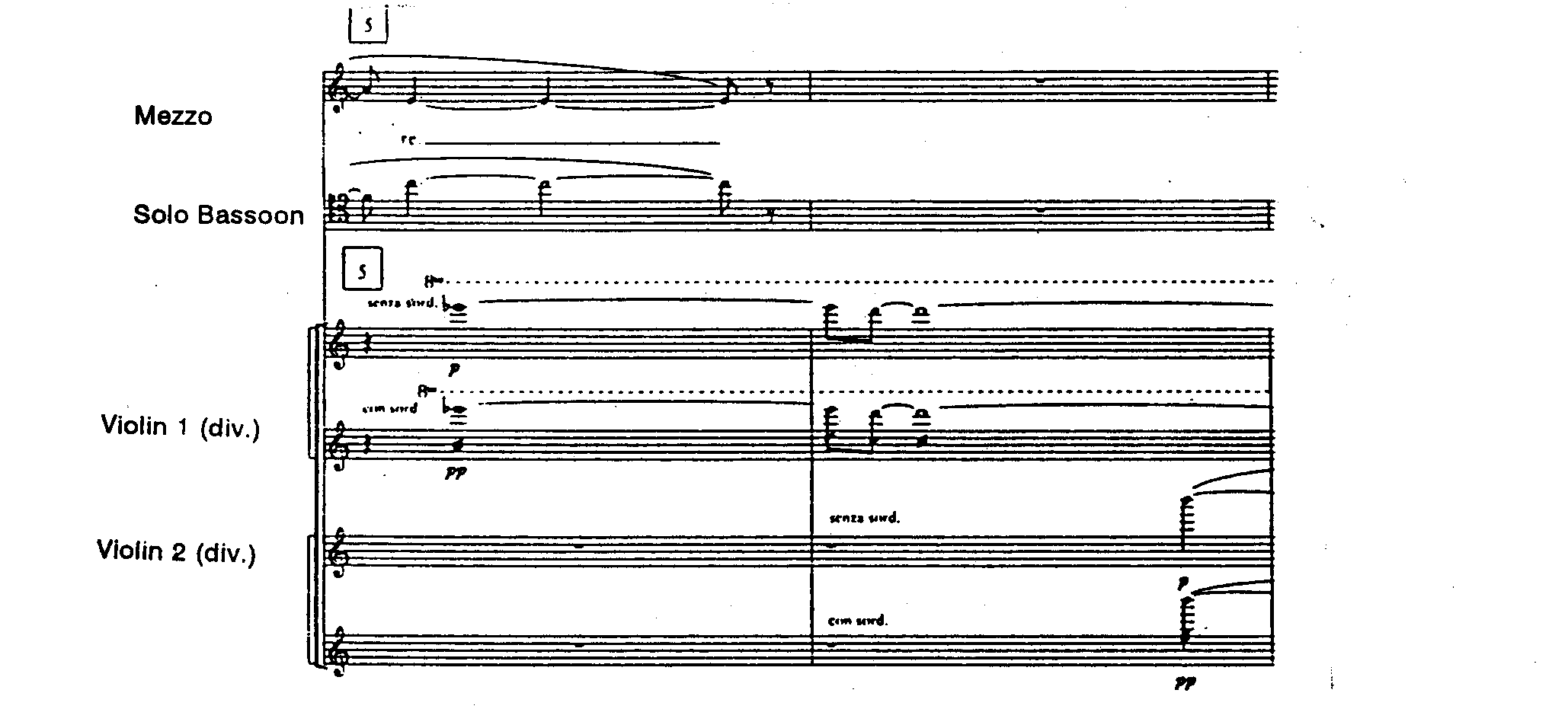
Example
3: "Il tramonte de
Fossoli," opening.
Does
the downward expansion of the range from the violins through the rest of the
strings in "Il tramonto di Fossoli" represent the setting of the sun?
No.
The
downward expansion of the range goes through the whole movement. You start with the high strings and gradually
move lower.
Yes,
absolutely. The direction and tessitura
of that line was worked out as one huge linear expanse. I was particularly curious to set up an
orchestrational event, which I think does work quite well. Each of the various string lines is split
into two parts: half the players are marked senza sordino, the others con
sordino. The players with their
mutes on play tremolo throughout the piece, creating an interesting unison
string mixture.
How
do you think of the relationship between the two soloists in the third
movement?
It
was my intention in this particular poem to give the entire melodic shape to
the bassoon. What happens in this piece
is a proliferating melodic line.
Formally, "Lunedi" has the most closed structure of all the
pieces. It took me a lot of time to get
into this poem, I just couldn't approach it at first, and I kept putting it
off. The poem is so poignant. "Is anything sadder than a train that
leaves when it is supposed to?" How
do you set that? The piece is built on
the succession of fixed elements which have the same bass line. But really, it's all about gradually
superimposing more and more materials.
At the same time, the bassoon is following the same contour, but just
gradually creating a different, a more florid outline. It actually ends the way it begins. It was the cry of that poem which I gave to
the bassoon. [Refer to Example 4.]

Example
4: Ad Ora Incerta, Third
Movement, Bassoon Part
I
had a different image for that movement.
The train sounds symbolize the first stanza and extend through the
entire song. Similarly, I thought the
bassoon represented the third stanza S
the sadness of Man B
through the entire movement as well. It
becomes more anguished as it leads to the textual presentation of the third
stanza when the bassoon really wails.
When the poetry of the sadness of Man is expressed, the bassoon sets
itself free.
To
a certain extent I would go with that interpretation. I think that is how I heard that. It is a cumulative thing gradually reaching
out.
It's
cumulative and it's also persistent.
Both are going along at the same time.
The train keeps going to demonstrate the first verse, "Is anything
sadder than a train...." The other
two stanzas answer that there is more that is sadder. Levi had to put these ideas in time, first
the train, then the carthorse, and finally the man. You overlay the temporal reality of the train
going for those four years with the sadness of man paralleling it.
Yes.
What
lies behind your rhythmic‑metric plan in "Lunedi"? You divide the six measures at the beginning
in different ways and then repeat them.
The bass line is divided into nine notes of eight equal parts. Against that are the triplets, which go
across the six measures and change every measure and a half, so this divides
these six measures into four parts. The
bassoon line has a symmetry of sorts; it opens up with a note lasting eleven
eighth notes, another lasting seven, then one of seven, and one of eleven
eighth notes. [Example 5 shows a partial
score in which one instrument represents each rhythmic strand.] Are you interested in dividing a block of time
in multiple ways? You did something like
that in the first movement, where you had three against four against five
against six. Is this something that you
do often? [Example 5‑ "Lunedi," opening 6 measures]
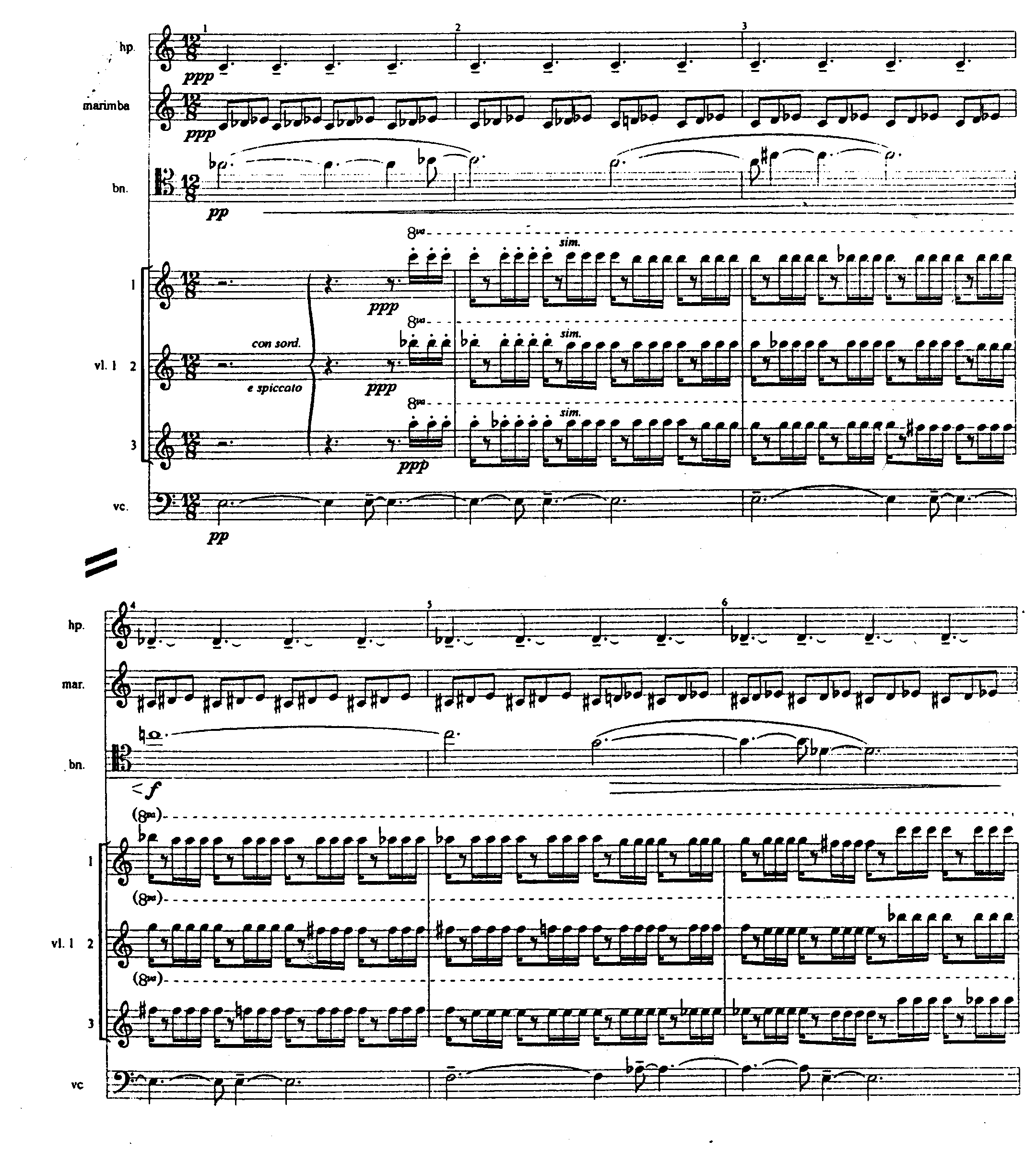
Example
5: "Lunedi," opening 6
measures
Absolutely.
I think one of the strongest aspects of this piece is the actual
superimposition of different time materials.
I understand what you're saying, I'm just not quite sure how I composed
the piece beyond setting up a superimposition of materials that operate in
different ways. The bass and the
gradually proliferating bassoon line operate together in effect. The triplet figuration, which goes throughout
the whole composition, is a representation of the train on the tracks. It was just a question of superimposing all
these materials into one huge harmonic block.
It is the most harmonic of all the movements. In fact, it was conceived that way rather
than in terms of the actual lines. I
can't remember how I actually worked out that rhythmic scheme you were talking
about beyond creating a six‑bar structure which is constantly repeating.
Are
you particularly drawn to the mezzo‑soprano voice?
I
am very drawn to the mezzo‑soprano voice.
In fact, I'm drawn to the dark‑hued colors. My Viola Concerto
was sparked by the world of Walter Trampler's recordings of the two Brahms
sonatas. I was a clarinetist when I was
a student, and I played those pieces in the clarinet version along with the
Brahms Trio. It's wonderful late,
autumnal music and has something about it which sticks. I've always adored Mahler's orchestral songs,
and, when I was given the commission, I spent a lot of time listening to
Brigitte Fassbaender's recordings of these pieces. I tried to get inside the
way she would sing them, and the piece was written with her voice in mind. When I got that fax some six weeks before the
premiere date to say that she had decided to end her career, it came as
somewhat of a blow.
A
number of people, including Paul Griffiths, who wrote the program notes for the
first performance of Ad Ora Incerta ,
suggest a certain kinship between my work and the music of Gustav Mahler. I think to an extent this is true (on a
subliminal level!) perhaps in some of the horn writing and the hint of a
funeral march at the beginning of "Buna." Most certainly Das Lied von der Erde
was a structural model with the dramatic weight and length of "Buna"
occurring similarly to "Der Abschied."
The
effect of the mezzo‑soprano with the bassoon is very striking in this
piece. The bassoon so often is in that
strained high register above the voice, and the voice is mostly in a low
register and often a confined range. It
conveys such a bleakly despairing mood so effectively.
Absolutely. There is that wonderful register of the mezzo
voice just below middle C. You know that
wonderful moment in the first movement of Mahler's Lieder eines fahrenden
Gesellen where the mezzo sings "Weine! Wein! um meine Schatz"
("Bitter tears shall I then weep")... [sings several measures]. Christa Ludwig was the first person I heard
sing that, and it's an extraordinary sound.
It's almost chested, and it has a richness which is totally unique to
that voice. Not all singers can get
it. That particular register was very
important to convey some of the textural aspects of the piece.
Did
you have any other particular musical reference in mind as you were composing
Ad Ora Incerta? Some of the text‑painting
elements traditionally associated with musical depictions of death and hell
seem rather noticeable: descending chromatic lines, for example, and the
prominence of the tritone in the latter movements.
Not
really. Musical references and ideas
tended to evolve naturally out of Levi's wonderful poetry. For example, I have tried to convey the dark
despair of "Buna" with a recurring motivic sigh in the bassoon
suggested by a falling semitone figuration along with the use of the tritone. I have to be quite honest, these musical objects
were in my head. I can't rationalize the
process, but they just became part of the way I heard the phrases. One creates frames of references which evolve
out of the words. These little objects
which I set out for myself became important in the way I developed the music.
You
weren't thinking in terms of half‑step descents in laments, such as in
"Dido's Lament"?
No.
I
wonder if it may be something natural in the human character to relate to half‑step
descent?
Absolutely. I think that is a very strong point there,
like the relationship between major and minor.
Yes,
there is something very visceral, a sort of archetypal symbolism there.
Absolutely,
yes.
When
you were writing for the bassoon, did you keep any passages from bassoon
literature in mind?
No. I just talked to Kim and asked, "How
about that, is that all right?"
I
suppose the world of The Rite of Spring was there. I adore that wonderful sound which uses the
instrument in such an extraordinary way.
To think that it was invented in 1913! In trying to discover the
character of this piece, I found that each movement in this composition
required a different world. This happens
with all my music, abstract and vocal.
It's a question of discovering an object and then exploring the potential
of that object. Finding a nucleus for
each piece that one writes is the hardest thing. It's something I talk to my students about.
One of the hardest things in this particular song cycle was to create a
different world for each poem.
Having
said that, there is a moment where I actually draw bassoon music from the first
movement, "Il canto del corvo," into the last movement,
"Buna." I did it
intentionally. I couldn't have
considered that had I not written "Buna" first. It occurs when "Il canto del corvo"
changes direction with the text, "This is the way he sang, dancing
vicious." Levi goes into that very
menacing world with the crow drawing a cross in the snow with its black beak
[Example 6a]. I felt that I needed to
make a connection with the world of "Buna" in that particular moment
of the piece. In m. 107, the bassoon has
the motive used throughout "Buna" [Example 6b].

Example
6a: Bassoon Motive in "Il canto
del corvo" 6b: Bassoon
Motive in "Buna"
So
by referring to the musical material of "Buna," the bassoon
foreshadows the bad news?
Yes.
Are
there motivic interconnections among any of the other movements? The triplets in the violas in "Il canto
del corvo" [Example 7a] look like
the train motive in "Lunedi" [Example 7b].

Example 7a: Viola
part, "Il canto del corvo" 7b: "Train motive" in
"Lunedi"
They
certainly do, but there isn't a connection.
Would
you care to tell us anything more about your methods of pitch organization in
the work as a whole, and in your other works, too? Do you think in terms of scales, chord structures,
unifying motives, and‑rather naively maybe S
do you conceive your music at all in relation to tonal centers?
Occasionally
I use a technique where the actual organization of the pitches is more
generalized over the entire composition.
I've always been very interested in working up from a melodic line. This can be traced back to the way I was
taught, through modal counterpoint. One
of the most fascinating things about that music is the fact that it combines
such wonderful harmony with counterpoint that works so beautifully. I decided to recreate this for myself some
years ago, and, in trying to rationalize this process, I came up with this
interesting method. I would start off
with a simple phrase, a line in its simplest form. This series of pivotal pitches is set off and
gradually ornamented both rhythmically and melodically so that the actual
melodic line gradually transforms. I see
these pitch and rhythmic modifications to the melody as a series of
superimpositions, and in my sketches I'll often write out maybe six versions of
that so it becomes more and more decorated, but all the notes of the original
still remaining. Then I'll do a
heterophonic version of the same material, so it has a completely different
rhythmic scheme. Once I've built up
maybe twelve layers of material, which is quite a complicated process, I can
immediately have a counterpoint which is created by using the original line with
the heterophonic version. Of course, a
heterophonic version can work at its simplest rhythmic level against a very
florid version of the same material.
Everything‑harmony, counterpoint, melodic material S
comes out of one source, which is the line.
Some rhythmic‑melodic language in "Buna" is derived from
this technique.
One
of the things that I had to deal with when working with the text was the
moment. I could no longer set up large
processes like the one described which actually control the whole form because
one is so dependent on the musical pacing of the words.
Let
me describe the way I composed this piece.
My Italian is limited to a knowledge of musical terms. However, Lynda does speak fluent Italian, and
she would read the text to me and onto a tape. Then we would go through carefully where the
stresses were, working with the English translation and the original
Italian. I then made a straightforward
realization of the poem, mapping out the actual stresses of the text. So what I had initially was just a
presentation of the text in speech patterns.
Then I started to formulate the contour and spent a lot of time going
over different versions, gradually elongating certain words and finding the
whole line of the poem before I did anything else. That was the most important thing for
me. I had to tackle the musical
realization of each of these poems as a series of tasks which gradually revealed
more about them. My initial sketch would
be one line, and then I would start to compose a contour for that shape. That would be hearing where the voice would
descend and ascend, while thinking about the tessitura of the voice. First I got an approximation of what the
voice would do, and then I discovered the intervals. This is a fascinating use of one's ears. It became very intuitive: hearing the sound,
thinking about the vocal line, and creating a singable line. I didn't have any preconceived notion of what
the notes were until I got inside the material.
Then I would discover the intervallic tensions for the voice, certain
intervals that I would use, and gradually they proliferated into the way the
piece developed.
In
reference to what you were asking about tonal centers in this piece, another
thing which I had to think about a lot in this piece was a directional bass
line rather than one that was just providing a pedal, because otherwise the
text would have consisted of embellished moments. My initial sketches consisted of bare two‑part
counterpoints. I had to make sure that
those two parts moved with a logic and tension.
You
weren't trying to come back to any single center, were you S
a single pitch overriding the entire movement?
Measure
9 of "Buna" has the first appearance of what I would call a recurring
funeral march [Example 8]. That minor
third figure on the harp and this falling semitone pattern come back. That would be the kind of focal image that I
keep coming back to. It occurs three
times: once at the beginning after the introduction, once in the middle in mm.
53 ‑ 56, and once at the very end in mm. 110 ‑ 115.
 Example
8: "Buna," m. 9-11.
Example
8: "Buna," m. 9-11.
But
it's more a matter of coming back to a particular configuration than coming
back to a particular pitch location?
Oh
yes, absolutely.
"Buna"
is both more sectional and more extended than the other movements. The motive that unifies the movement is heard
throughout in the bassoon and the rest of the orchestra but is hardly ever
given to the voice. However, after the
beautiful oboe passage which begins at m. 81, the voice seems to have the
motive around m. 84 [Example 9].
The
intention was actually to separate the voice and bassoon throughout.
In
that regard the voice becomes more of a soloist and the motive is a ritornello.
Yes,
okay.
Although
the separation was intentional, was it also intentional to bring the voice in
with that motive?
The
words are "Compagno vuoto che non hai." The recurring "che non hai" is set
to a recurring motive. "Che non
hai" occurs four times. The little
triplet figuration was very important to this part of the text. This is the only point in the whole poem where
there is really any repetition. The motive carries through in the use of
triplet. It was very much an intention
to set up a motive that proliferates itself in the development of that phrase. It derived from the text rather than the
music, although they are quite similar.
Would
you discuss giving the motive to all the instruments over the course of
"Buna"?
This
is the very first thing I wrote. I was
very conscious of trying to create a role for the voice which was not connected
to the bassoon by material but rather has a strong connection in other
terms. The bassoon represents something
that the voice can never express. They
are connected on one level. In part, the
connection is that they are both soloists.
Their material is different but they resonate off each other.
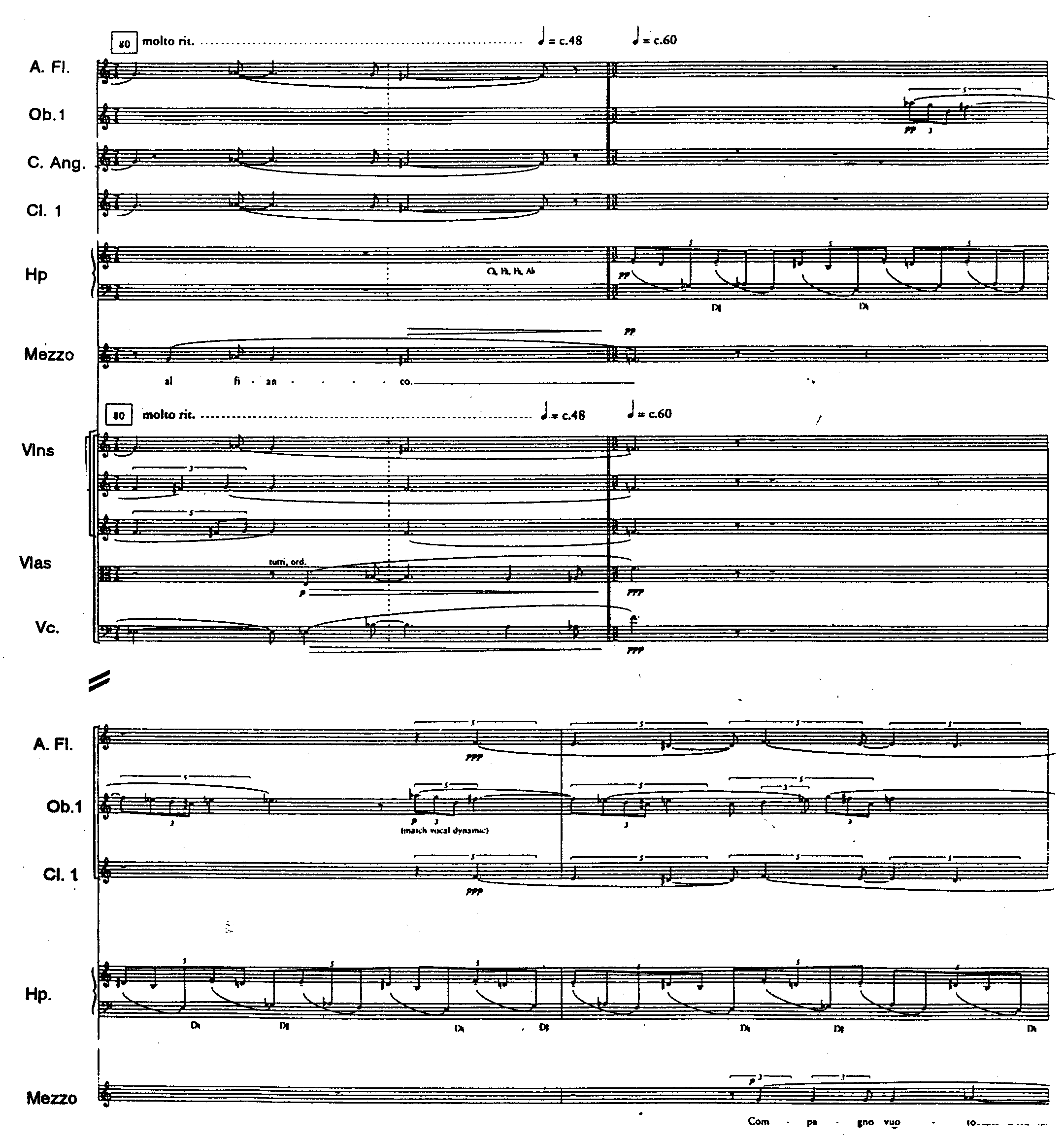
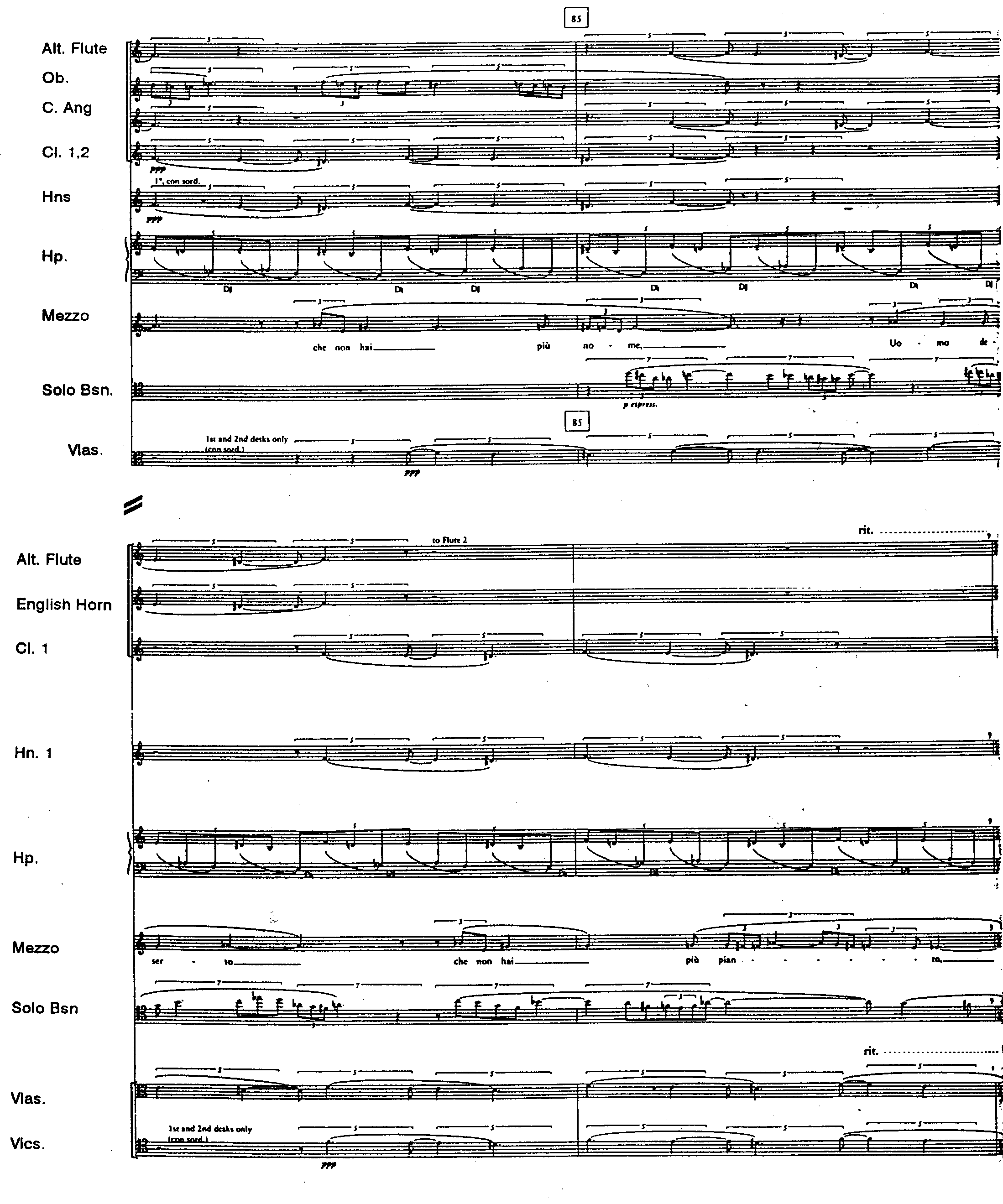
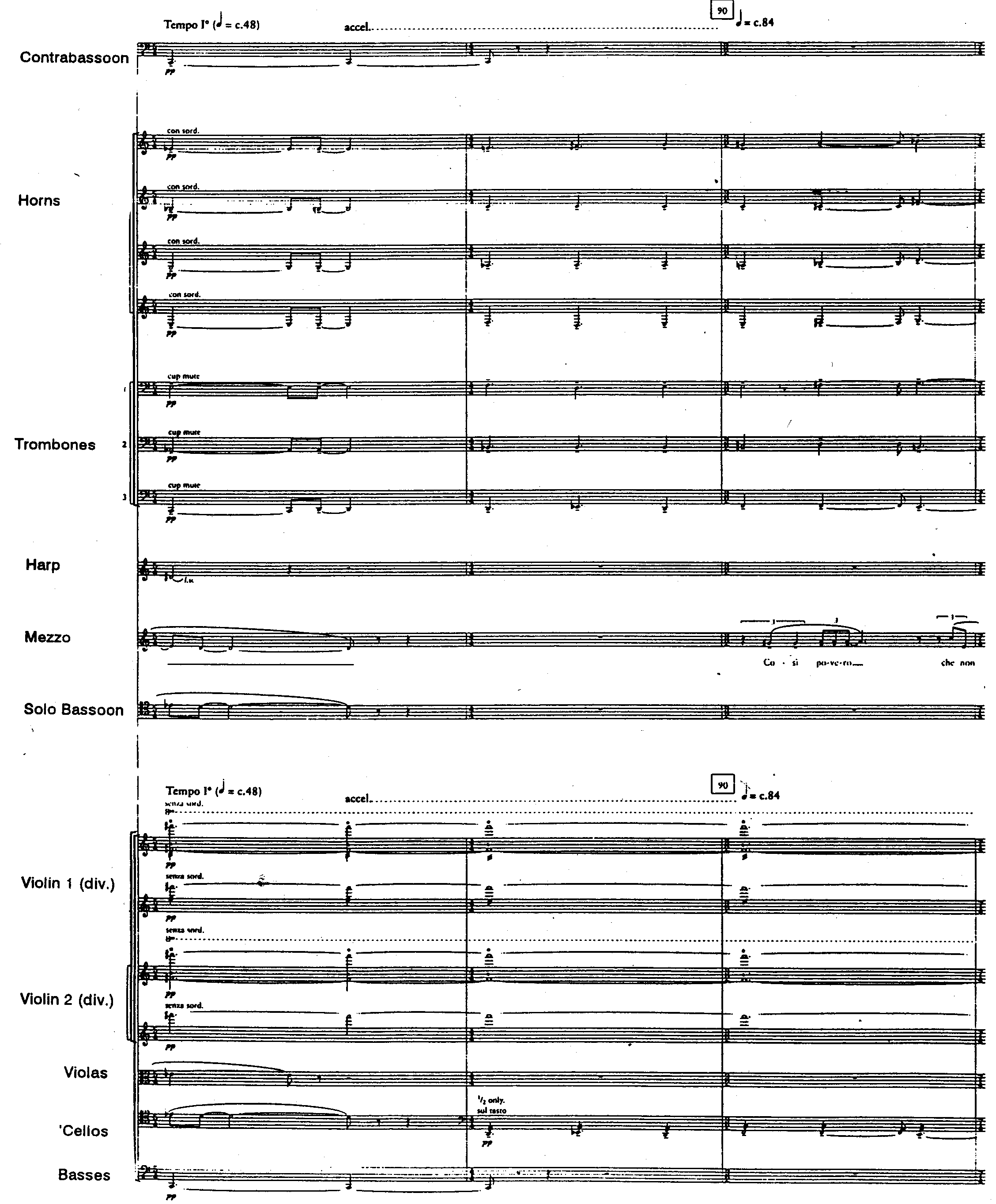
Example
9: "Buna," mm. 80 - 90
Of
course, they do appear in unison only once in the entire composition at m.
57. This is an important aspect of this
movement. Suddenly the bassoon line
which has been so different draws itself into the voice at "Tired
companion." There was definitely
some intention to unite the two voices at one moment. The relationship of companionship needed to
be solidified by the unison writing there.
Would
you discuss the canonic or stretto treatment of the motive? For instance, the violas, English horn,
bassoon, and piccolo have the motive in close proximity around m. 53.
In
fact, the texture was much more complex.
I thinned it out. Before the
first rehearsal of this piece, the writing for the piccolo and flute was more
ornate. As you can see from the score, I
had to cut it out because it was overcomplicated. The process of thinning was important from
the final composition stage to the period where I was rehearsing the piece.
Absolutely,
the intent was to treat them canonically.
It's related to the process I was talking about earlier. The material in the piccolo is an elaborated
version of the material from this bassoon part.
You
seem to use textural manipulation, the addition and subtraction of instruments
and parts to create some of your larger harmonic sonorities, as at the end of
the short introductory section of "Buna," around mm. 7‑8. The end of the first movement builds up a
tone cluster in the strings by stopping those lines at different points. Is that something you have done very
deliberately in Ad Ora Incerta? Is it
related to techniques you use in other compositions?
I
have used those techniques in other compositions. Can we look at specific spots?
In
mm. 118‑119 of "Il canto del corvo" [Example
10], you stop the ascending lines at different points to build up a chord.
That's
right, yes. It's a paralyzing of the
notes, so the texture proliferates from notes into a cluster. I have used that technique a few times. The other place is in mm. 7‑8 of
"Buna" where the gradual addition of notes builds up that big
chord. That was basically just taking
one huge harmonic object and making a pyramid of it, so that it gradually
saturated itself from a fundamental note all the way up to a twelve‑part
texture at the very end. [Example 11
shows this process from the beginning of the movement.]
Texture
as a whole seems to be a very interesting aspect of the piece.
Texture
is very important to me in the actual composition of a piece. Before I can think about a piece
harmonically, I have to hear the actual voicing of the instruments. This is very much like Debussy. The coloring of the chord, the placement of
the pitches, in essence the actual color of a piece, the instrumentation of the
piece, and the way I hear the chords are all very much tied up together. That is something which extends throughout a
lot of my music. As opposed to writing a
piano score and then orchestrating it, I need to be much more involved with the
color from the outset. I was once
described by a colleague of mine in England as writing timbral harmony. That is a very good description of the way I
approach harmony in particular, and the notion of timbral harmony was the key
to unlocking the possibilities of solo mezzo‑soprano and bassoon within
the context of the orchestral color and fabric of the composition.
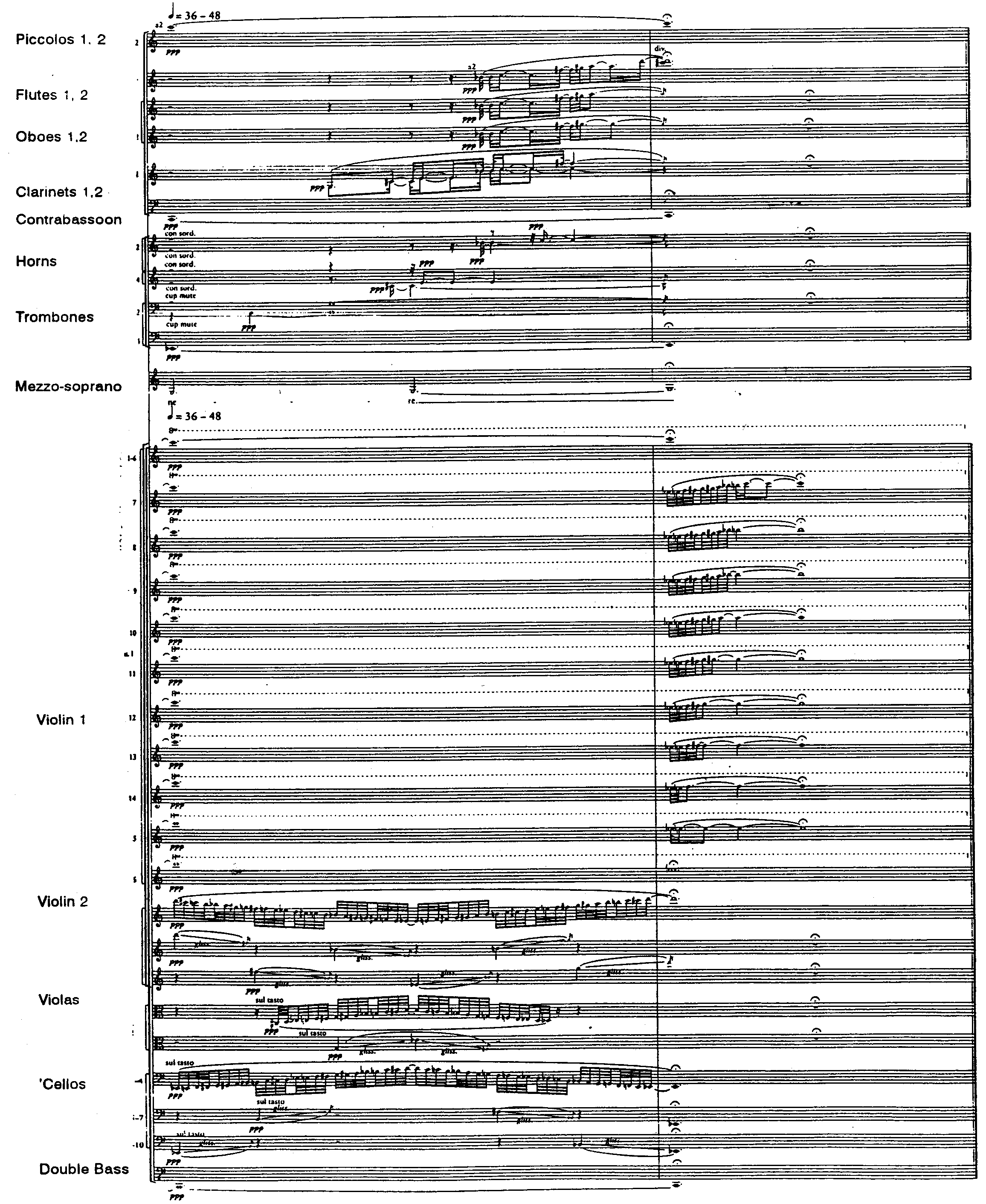
Example
10: "Il canto del corvo,"
mm. 118 - 119
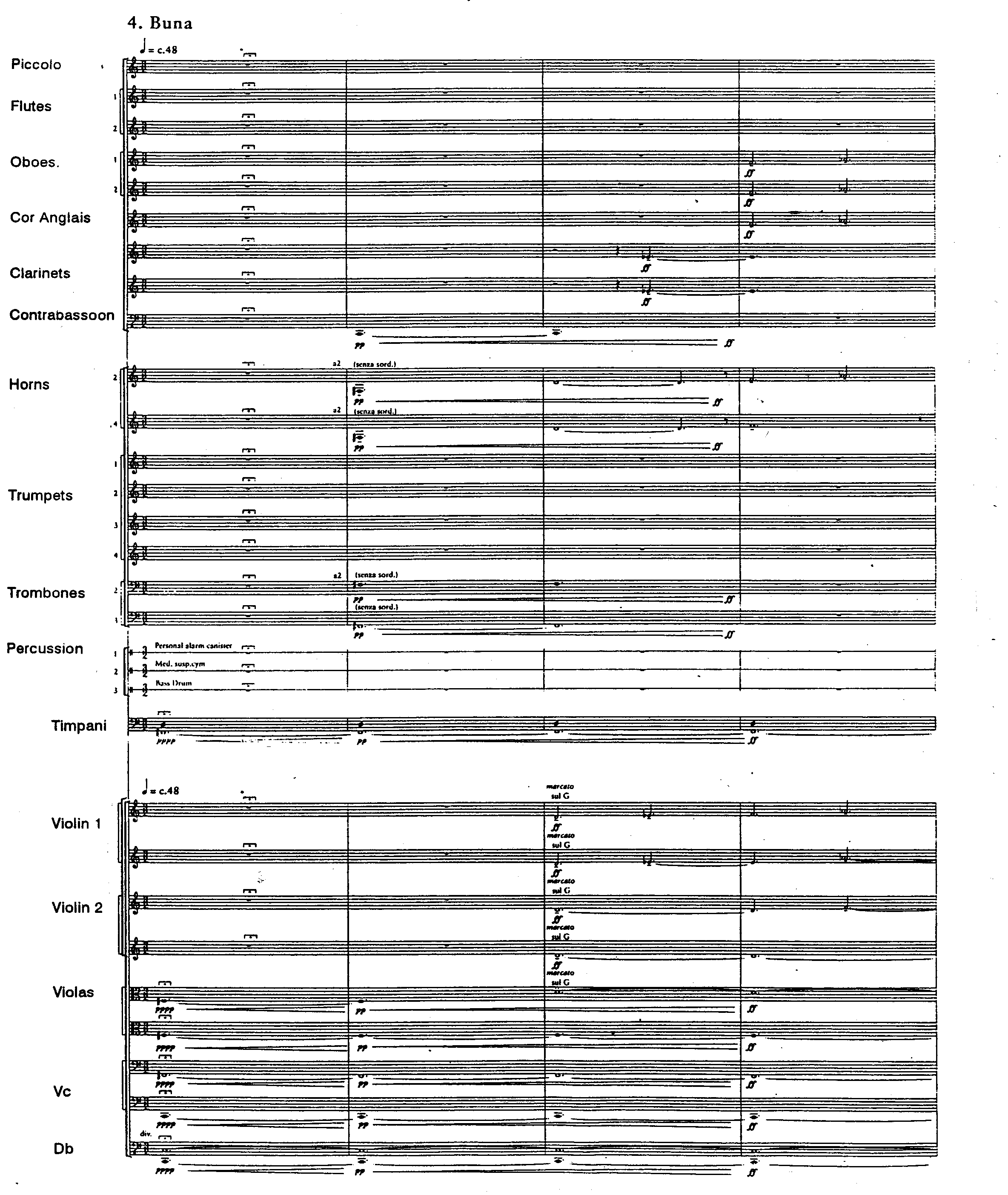
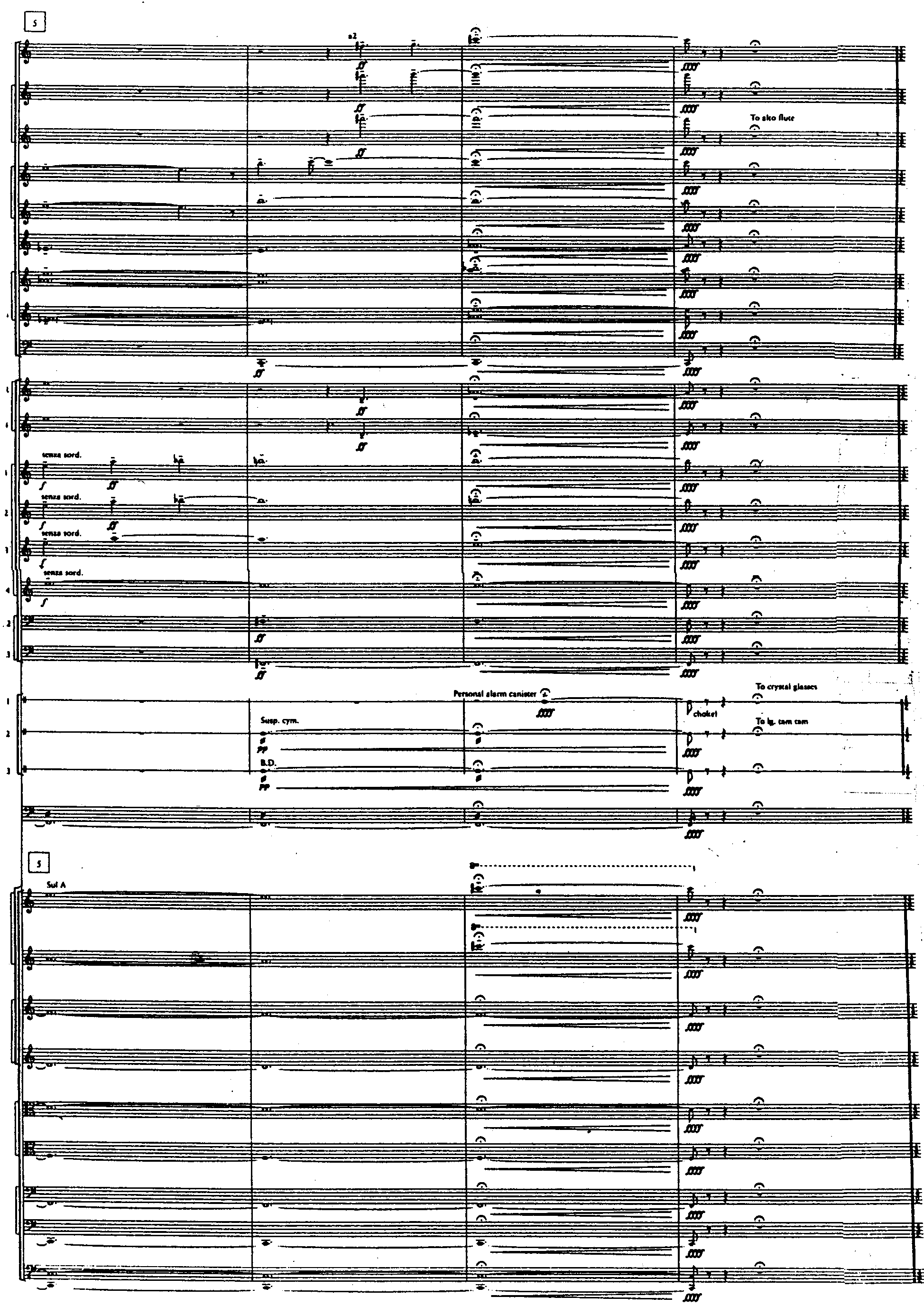
Example
11: "Buna" mm. 1 - 8
Bainbridge's visit to Louisville
in October 1997 to accept the Grawemeyer Award gave the authors the opportunity
to interview him about his work.
Bainbridge has approved this edited version of the interview.
The Grawemeyer Award in Music
Composition is one of five annual awards (the others are Education, Improving
World Order, Religion, and Psychology) given by the University of Louisville
(the Louisville Presbyterian Theological Seminary co‑sponsors the Award
in Religion). Endowed by the late H.
Charles Grawemeyer, a Louisville businessman and philanthropist, the awards
were begun in 1985. The Award in Music
Composition is chosen by three panels who select from pieces premiered in the
preceding five years. The scores and
recordings submitted to the competition are then stored in the Dwight Anderson
Memorial Library. The Grawemeyer
Collection grows annually and represents one of the outstanding repositories of
contemporary music. Access to the
Grawemeyer Collection is available to scholars by contacting the library. (Dwight Anderson Memorial Library, University
of Louisville, School of Music, Louisville KY 40292; www.louisville.edu/library/music/)
A book covers the winners of the
Grawemeyer Awards from their inception to the 1997 winners. Paul Brink wrote the chapters on the Awards
in Music Composition. Paul Weber, Allan
E. Dittmer, Eugene March, and Paul Brink, The Power of Ideas: the University
of Louisville Grawemeyer Awards in Music, Education, Religion, and World Order (Ashland,
Ky.: Jesse Stuart Foundation, 2000).
Two other articles about Ad Ora
Incerta have been published. Ronald
Klimko provides background of the commission and a description of the piece in
"Kim Walker Premieres a New Work for Mezzo Soprano, Bassoon and
Orchestra" (The Double Reed 21/3 (December 1998): 74), and Matthew
Karr discusses the piece from a bassoonist's perspective in "The Extreme
Challenges of Simon Bainbridge's At an Uncertain Hour" (The
Double Reed 22/1 (March 1999): 99‑101).
Simon Bainbridge. Ad Ora Incerta: Four Orchestral Songs
from Primo Levi. London: Novello,
1999.
The recording is NMC D059,
released in London in 1999.
Simon Bainbridge. Four Primo Levi Settings for mezzo‑soprano,
clarinet, viola, and piano. London:
Novello, 1996.
John Lambert, 1926‑95,
studied at the Royal Academy of Music, the Royal College of Music, and with
Nadia Boulanger. The list of his
students reads like a Who's Who of late twentieth‑century British
composers.
Simon Bainbridge, Herbsttag,
London: Novello, 1993.
Ad Ora Incerta: Four Orchestral Songs from Primo Levi by
Simon Bainbridge. Copyright
8
by Novello & Co., Ltd. International
Copyright Secured. All Rights
Reserved. Reprinted by permission of G.
Schirmer, Inc. (ASCAP) as USA agents for Novello & Co., Ltd.
Simon Bainbridge, Viola Concerto, London: United Music
Publishers, 1981. Recordings of this
piece are available on Unicorn RHD 400 and Continuum CCD 1020.
Paul Griffiths also provided the
liner notes for the recording of Ad Ora Incerta.
Lynda Richardson, who is married
to Simon, is a professional singer in London.
Trained at Trinity College of London, she sang for many years with the
Ambrosian Singers and as a studio singer.
She now teaches at Mountview Theatre School as Head of Singing and at
the Centre for Young Musicians.














